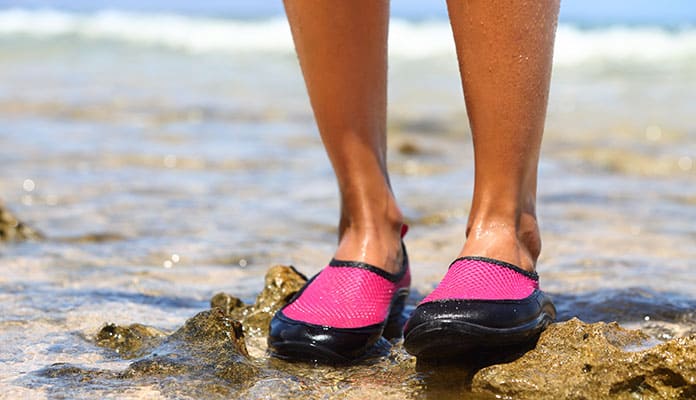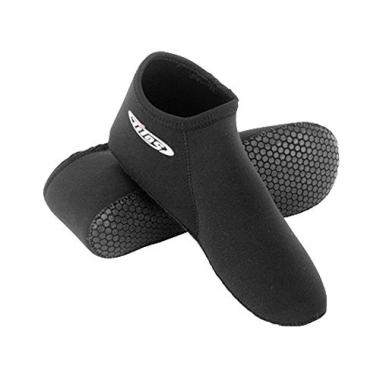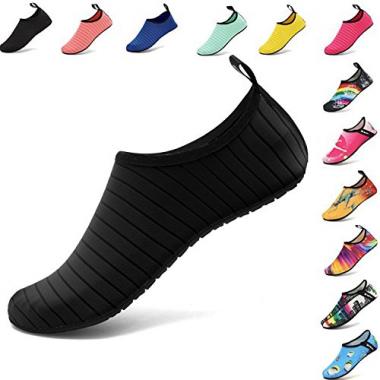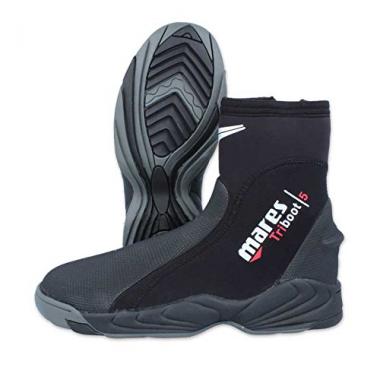
Ever stepped on a sharp rock or shell while strolling barefoot on the beach? Ever slipped on a mossy rock while crossing a stream on your flip flops? If so, then you probably already understand how important it is to wear the proper footwear for water-related activities.
Different types of footwear are suitable for water sports and activities. In this article, we’ll give you an overview of the different kinds of water footwear, explain the difference between water shoes and water socks (and wet boots, too), and provide you with basic tips you should keep in mind when purchasing your first aquatic footwear.
Design
Let’s take a look at the more obvious difference between water socks, water shoes, and wet boots: the design.
Water socks sometimes referred to as aqua socks, look pretty much like your everyday socks. However, unlike ordinary socks which are commonly made from cotton, water socks are made from materials like lycra or neoprene. They also come in different heights like ankle-high or high-tops, and some even have adjustable ankle cuffs to adjust the fit and hold your socks up while you’re walking or swimming.
Water shoes have soles made from rubber and a mesh top. The flexible rubber soles are designed to promote comfort and excellent traction for wet surfaces, while the mesh tops provide breathability and allow water shoes to dry quickly. The holes in the mesh tops also allow water to flow in and out of the shoes freely so they don’t get water-logged. There are slip-on water shoes that are perfect for walking and swimming, and there are also lace-up water shoes that are designed for more intense activities like hiking, crossing streams, and shallow rivers.
Wet boots come in two different designs: the round-toe and the split-toe. As their name suggests, round-toe wet boots have rounded end toe covers, whereas split-toe wet boots have the big toe separated from the rest of your toes. Between the two, round-toe wet boots are more popular since they are relatively inexpensive.
Purpose
Water socks, water shoes, and wet boots are used for specific purposes and activities.
Water socks are primarily worn by snorkelers to prevent their snorkeling fins from rubbing against the skin on their feet since excessive rubbing can result in chaffing and even blisters. High-top water socks are also worn along with low-cut water shoes for added protection against jellyfish stings and other similar hazards.
Water shoes are used for a variety of purposes and water activities. They can be worn when strolling down the beach, swimming, hiking on wet and rocky areas, paddle boarding, and many more. Because water shoes are at home on both water and land, this makes it the perfect footwear for those who are going on kayak camping trips.
Wet boots are usually used by surfers and paddleboarders. This is because wet boots have specially designed soles that provide excellent grip on a board’s surface. There are also more technical wet boots that are designed specifically for diving and other underwater activities.
Buying Water Footwear
Before you rush to your nearest dive shop or start browsing online, take note of the following tips to make sure you don’t end up buying the wrong water footwear.
Understand Your Needs
Some footwear offers better features than others, as is the case with water socks. As mentioned earlier, water socks can either be made from lycra or neoprene. If you are looking for water socks that keep your feet warm and offer added cushion, then you should consider getting those made from neoprene since they have better-insulating properties.
Buy Quality Water Footwear
High-quality water footwear is made from excellent materials and craftsmanship, ensuring that they will last you for a reasonably long time. And yes, high-quality water footwear performs much better than their cheap versions. For instance, high-quality water shoes will have soles that provide better traction which helps reduce any chance of you slipping.
Get the Right Size
Wearing ill-fitting water shoes or wet boots can be very uncomfortable and painful, so make sure that you get the right size. If you are buying from actual stores, you should try the shoes or boots to ensure that they fit perfectly. If you are buying your water shoes or socks online, be sure to check the sizing guides in the product descriptions since there may be variations in how manufacturers size their footwear.
You might also like: Waterproof Socks
FAQs
Q: What Are Aqua Socks Used for?
Aqua socks, which are also known as water socks, are usually worn by snorkelers to prevent excessive rubbing between their snorkeling fins and their feet – excess rubbing often results in blisters and chaffing. Additionally, high-top water socks are usually worn together with low-cut water shoes for added protection from jellyfish stings.
Q: What is the Difference Between Aqua Socks and Water Shoes?
Aqua socks are socks that are worn in shoes that will get waterlogged or wet. Aqua socks are also worn together with snorkeling fins. Water shoes, on the other hand, are shoes worn (with socks or barefoot) in wet conditions such as river hiking, rafting, at the beach, when kayaking, etc.
Q: Do Water Socks Work?
Water socks work incredibly well when submerged in water – after all, this is what the socks are designed for. They offer you the grip and protection your feet need to walk on the rocky shore especially in the ocean.
For snorkelers, the socks eliminate excessive rubbing between their feet and the snorkeling fins. When worn together with the water shoes, high-top water socks offer added protection against jellyfish stings.
Q: Do You Wear Socks with Aqua Shoes?
It is not mandatory that you wear aqua shoes together with the water socks. However, wearing water shoes together with the water socks is always a good idea considering that the socks improve warmth and also offer protection against various hazards, including jellyfish stings. It is worth noting that water socks are generally designed to be worn with something else – if you don’t wear them with your water shoes, you can wear them with your snorkeling fins for protection against excessive rubbing.
Globo Surf Overview
Whether you’re on a saltwater hiking through mountains with streams and shallow rivers, make sure that you’re wearing the appropriate water footwear to keep your feet dry, warm, and well-protected. By knowing the difference between water shoes and water socks (and let’s not forget the wet boots), you should be able to determine which footwear to use for which activity.




